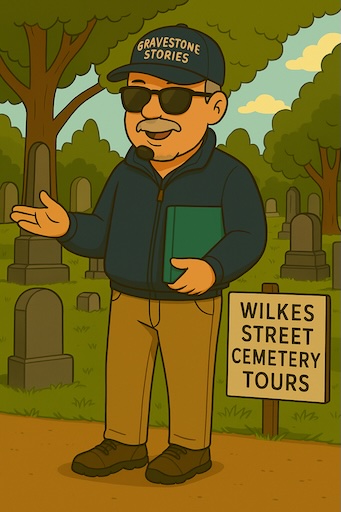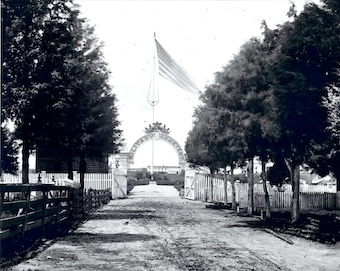William Gregory III (born on March 3, 1789, and passed away on July 13, 1875) was originally from Kilmarnock, Scotland. He became well-known as a merchant in Alexandria, Virginia, after immigrating to the United States in 1807. From 1847 to 1866, he served as the President of the Alexandria branch of the Farmer’s Merchant Bank. William Gregory III was also the last surviving member of the Alexandria Blues, who participated in the historic Battle of the White House. You can learn more about this battle at this [Link].
Elder in the Presbyterian Church
Gregory was a respected member and an Elder of the Meeting House who married Margaret Douglas Bartleman (birthdate unknown – June 13, 1833) in 1822. They had several children, including Douglas Smith Gregory (October 22, 1824 – July 22, 1872), Elizabeth “Eliza” Smith Smith Gregory Ashby (December 19, 1826 – December 13, 1892), Dr. William Bartleman Gregory (March 13, 1829 – May 18, 1887), and Margaret “Mag” Douglas Gregory Ashby (April 27, 1831 – February 24, 1892). Unfortunately, Margaret passed away from tuberculosis in Barbados in 1833 while there with William, hoping the climate would help her recover. Her body was transported back to Alexandria in a lead casket and laid to rest in the Presbyterian Cemetery (41:31, tombstone).
Second Marriage
In 1838, he got married again. This time, he married Mary Donaldson Long. Mary was also a member of the Meeting House, but she later left to join the Second Presbyterian Church. They had several children together. They were Isobel “Belle” Ann Gregory Johnston, Julia Harper Gregory Chapman, Boyd Gregory, Mary Gregory Craufurd Powell, and Janet “Jessie” Boyd Gregory Leadbeater. All of them, along with their spouses, are buried in the Presbyterian Cemetery.
Family Home
The family lived at 329 North Washington Street, called the Leadbeater house. The Leadbeater family were partners with the Stabler family in the Stabler-Leadbeater Apothecary shop on South Royal Street, now a museum. One of the last workers of the store, William Gregory Leadbeater (November 25, 1882 – July 13, 1967), is also buried in the cemetery. His mother was Jessie Leadbeater.
The Mount Vernon Cotton Factory
Gregory was an investor in the Mount Vernon Cotton factory, which was constructed in 1848. During the Civil War, the factory served as a prison for Confederate prisoners of war and Union deserters. From 1902 to 1916, it was used as a bottling plant for the Portner Brewing Company, the largest brewer in the South. After prohibition caused the closure of Portner, the building was converted into a spark plug factory until 1928. Despite undergoing various transformations, the building remains at its original location, 515 N. Washington Street, and now consists of condominiums.
Country Estate Strathblane
Gregory had another house near Alexandria that had a nice view of a stream called Holmes Run. He named this house “Strathblane” after his family’s home in Scotland. The family spent their summers in this house to escape Alexandria’s loudness and dirtiness.

During the Civil War, the Union took over the house, cut down trees, ruined furniture, and carved their initials on the wooden parts. The house still stands today. However, it is now located within the city limits because the city expanded in the 1950s and annexed the land.

After he died, Gregory was buried in section 44, plot 141, where many family members are buried too!

| WILLIAM GREGORY born in Kilmarnock, Scotland March 3, 1789 Died July 13, 1875 |
Sources of Information
The Alexandria Association April 12- May 12, 1956. Our Town 1749-1865 at Gadsby’s Tavern Alexandria, Virginia. The Dietz Printing Company. 1956.
Pippenger, Wesley E. Tombstone Inscriptions of Alexandria, Virginia: Volume 1, Family Line Publications, Westminster, MD, and Heritage Books, Inc., Bowie, MD. 1992.
Powell, Mary Gregory. Index by Pippenger, Wesley E. The History of Old Alexandria, VA, from July 13, 1749 – May 24, 1861. Westminster, Maryland, Willow Bend Books. 2000.
Hamilton, Ellen J. A Scottish Migration to Alexandria. Alexandria, Virginia. Ellen J. Hamilton. 2021.
Dahmann, Donald C., Archivist, Old Presbyterian Meeting House member. The roster of Historic Congregational Members of the Old Presbyterian Meeting House. Updated 2022.
Mr. Phillip and Tica Gibson, descendants of Mr. William Gregory III, provided selected notes and spoke of family memories in June 2023.






